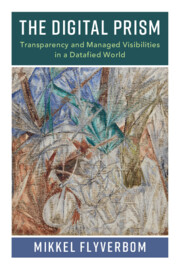Book contents
- The Digital Prism
- The Digital Prism
- Copyright page
- Contents
- Acknowledgments
- Introduction: The Transparency Formula
- 1 Digital and Datafied Spaces
- 2 Transparency and Managed Visibilities
- 3 People under Scrutiny
- 4 Organizations Gone Transparent
- 5 Seeing the World
- Conclusion: Life in the Digital Prism
- Bibliography
- Index
1 - Digital and Datafied Spaces
Published online by Cambridge University Press: 27 September 2019
- The Digital Prism
- The Digital Prism
- Copyright page
- Contents
- Acknowledgments
- Introduction: The Transparency Formula
- 1 Digital and Datafied Spaces
- 2 Transparency and Managed Visibilities
- 3 People under Scrutiny
- 4 Organizations Gone Transparent
- 5 Seeing the World
- Conclusion: Life in the Digital Prism
- Bibliography
- Index
Summary
Promises of technological progress have always intrigued humankind. Throughout history, people have imagined what they could accomplish with stronger tools, faster machines and more advanced technologies. Such hopes about technological transformations continue to shape most domains of life, from economies and production over social relations to politics and knowledge. The hopes associated with contemporary digital transformations are no exception. The internet and mobile technologies make it easier than ever to find information and communicate. Big data gives us direct, precise insights into all aspects of human life. Right around the corner, artificial intelligence may lead to faster and smarter decision-making. While we often experience that the reality of such developments is more complicated, most technological revolutions are welcomed with the same kind of enthusiasm (Marvin, 1988). Likewise, many companies and other organizations scramble to stay up to speed and fear falling behind the pace of technology while they are busy attending to the core of their work. As a result, most organizations contain departments and people who are on completely different pages when it comes to understanding and working with digital transformations. That is, organizations are simultaneously doing some things in very handheld ways, relying on digital technologies for a wide range of activities and experimenting with big data or artificial intelligence in some parts.
- Type
- Chapter
- Information
- The Digital PrismTransparency and Managed Visibilities in a Datafied World, pp. 25 - 38Publisher: Cambridge University PressPrint publication year: 2019

